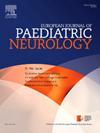CSF IL-6 in children with neuroinflammatory conditions
IF 2.3
3区 医学
Q3 CLINICAL NEUROLOGY
引用次数: 0
Abstract
Introduction
Cerebrospinal fluid (CSF) cytokines may contribute to immune-mediated processes affecting the central nervous system (CNS). We evaluated CSF cytokine profiles in children with suspected neuroinflammatory conditions to explore their clinical relevance.
Methods
Between 2019 and 2024, CSF from children <18 years were analyzed using BD Biosciences cytokine bead array for interleukin-2 (IL-2), IL-4, IL-6, IL-10, interferon-alpha (IFN-α), and tumour necrosis-factor-alpha (TNF-α). Clinical phenotyping was conducted. Serum cytokine levels were measured in cases with abnormal CSF, when available.
Results
112 patients were included (median age 6 years [IQR 3.6–11.2]; 54 % male). CSF IL-6 was raised in 35/112 (31 %; median 107 pg/ml, IQR 24–329). No other cytokine was raised without concurrent IL-6. Raised CSF IL-6 occurred in 16/50 acquired neuroimmune conditions (including myelin oligodendrocyte glycoprotein antibody-associated disease, seronegative demyelination, seronegative autoimmune encephalitis, and febrile-infection-related epilepsy syndrome), 5/9 CNS infections; 9/17 monogenic autoinflammatory syndromes, and 5/7 cancer treatment-related neurotoxicities.
Of the 35 patients with raised CSF IL-6, 21 had serum cytokines tested; 13 (62 %) showed elevated serum IL-6. In demyelinating cases, higher IL-6 was associated with increased CSF protein (p = 0.007). Follow-up CSF samples (n = 16, median 34 days) showed persistent elevation in 7 and normalisation in 9. IL-6 inhibitors (tocilizumab and/or siltuximab) were used in 10 patients with variable outcomes, depending on the underlying etiology.
Conclusions
CSF IL-6 was the most frequently elevated cytokine in our cohort, observed across a range of primary and secondary neuroinflammatory disorders. While not diagnostic of a specific condition, its elevation may help guide treatment decisions.
脑脊液IL-6与儿童神经炎症的关系
脑脊液(CSF)细胞因子可能有助于影响中枢神经系统(CNS)的免疫介导过程。我们评估了疑似神经炎症的儿童脑脊液细胞因子谱,以探讨其临床相关性。方法采用BD Biosciences细胞因子头阵列分析2019年至2024年间来自18岁儿童的脑脊液中白细胞介素-2 (IL-2)、IL-4、IL-6、IL-10、干扰素-α (IFN-α)和肿瘤坏死因子-α (TNF-α)的含量。进行临床表型分析。在脑脊液异常的情况下,测定血清细胞因子水平。结果纳入112例患者(中位年龄6岁[IQR 3.6-11.2];54%男性)。CSF IL-6升高35/112 (31%;中位数107 pg/ml, IQR 24-329)。没有IL-6的同时,其他细胞因子均未升高。CSF IL-6升高发生在16/50的获得性神经免疫疾病(包括髓鞘少突胶质细胞糖蛋白抗体相关疾病、血清阴性脱髓鞘、血清阴性自身免疫性脑炎和发热感染相关性癫痫综合征)和5/9的中枢神经系统感染中;9/17是单基因自身炎症综合征,5/7是癌症治疗相关的神经毒性。在35例CSF IL-6升高的患者中,21例进行了血清细胞因子检测;13例(62%)血清IL-6升高。在脱髓鞘病例中,高IL-6与CSF蛋白升高相关(p = 0.007)。随访的脑脊液样本(n = 16,中位34天)显示7例持续升高,9例恢复正常。IL-6抑制剂(tocilizumab和/或siltuximab)用于10例患者,根据潜在病因,结果不同。结论:在我们的队列中,在一系列原发性和继发性神经炎性疾病中观察到,scsf IL-6是最常升高的细胞因子。虽然不能诊断出特定的疾病,但它的升高可能有助于指导治疗决策。
本文章由计算机程序翻译,如有差异,请以英文原文为准。
求助全文
约1分钟内获得全文
求助全文
来源期刊
CiteScore
6.30
自引率
3.20%
发文量
115
审稿时长
81 days
期刊介绍:
The European Journal of Paediatric Neurology is the Official Journal of the European Paediatric Neurology Society, successor to the long-established European Federation of Child Neurology Societies.
Under the guidance of a prestigious International editorial board, this multi-disciplinary journal publishes exciting clinical and experimental research in this rapidly expanding field. High quality papers written by leading experts encompass all the major diseases including epilepsy, movement disorders, neuromuscular disorders, neurodegenerative disorders and intellectual disability.
Other exciting highlights include articles on brain imaging and neonatal neurology, and the publication of regularly updated tables relating to the main groups of disorders.

 求助内容:
求助内容: 应助结果提醒方式:
应助结果提醒方式:


